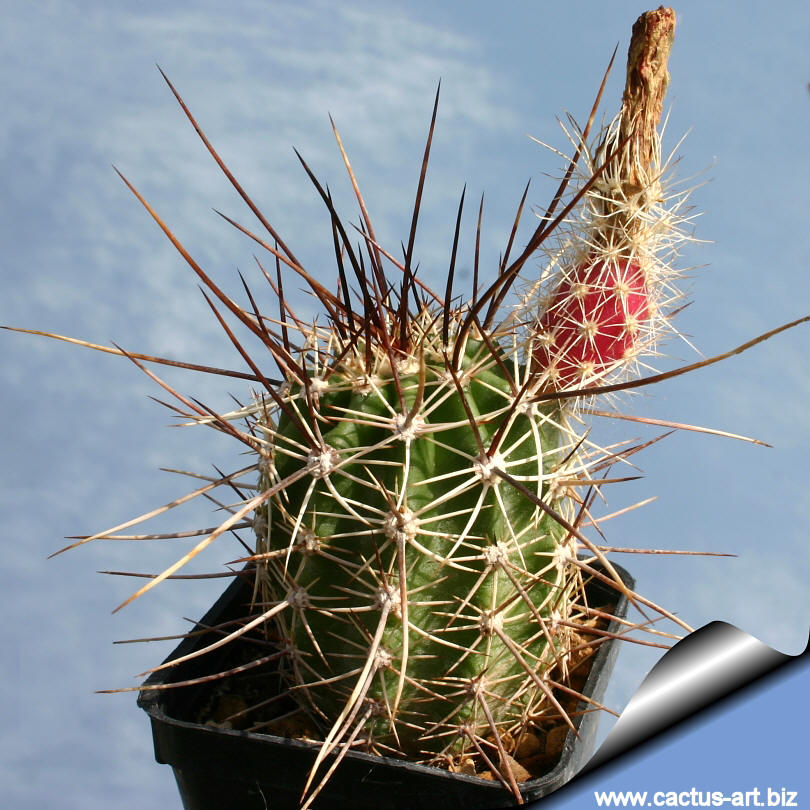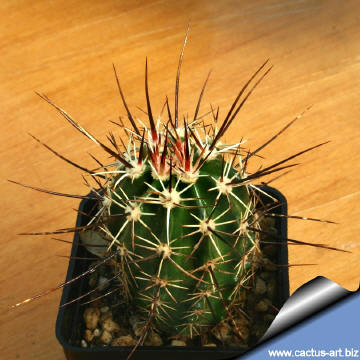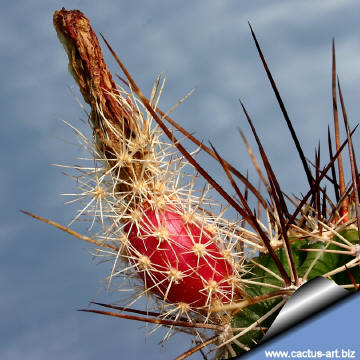|
|
|

Echinocereus engelmannii var.
variegatus
|
|
Desription:
E. engelmanni is a clumping columnar
cactus, 3-60-branched, ultimately forming somewhat open clumps of stems
which can spread out as large as 1m in size. It a highly variable
species; sometimes divided into vars. but not satisfactorily.
Stems: Mostly erect light green, cylindrical or somewhat tapering
distally, 10-30 (or more up to 60 cm) cm tall, 5-10 cm diameter,
branching freely from the base;
Ribs: 11 to 14 low obtuse, tubercles indistinct, crests slightly
undulate.
Areoles: 6-15 mm apart, wool present in first year only.
Spines: 8-20 per areole, usually straight (curved and twisted in
desert mountains and peninsular ranges of California), individual spines
with broad zones of different colours:
Central spines: 4 to 6 whitish or greyish, dull golden-yellow, or
reddish brown to nearly black., 5-7 (< 8) cm long; divergent-porrect
Radial spines: 8 to 20 (or more) mm long .
Flowers: The more common form has bright pink flowers (Often
varying from paler to darker in same population) but some varieties have
different colours, from purple to lavender. The flowers are up to 7 cm
in diameter, 5-13 cm long . Flower tube hairy. Anthers yellow, Stigma
green in the centre.
Blooming phenology: Spring (February to April), flowers are
diurnal close at night and reopen in the morning and last for about five
days.
Fruit: Red or orangish 2.5-4 cm long, spherical, fleshy, pulp
whitish be-coming infused with pink or red from the skin. Spine clusters
deciduous. The fruit is edible (if you can reach through the spines). It
is said to taste like strawberry, and is eaten readily by birds and
rodents. Fruiting May-Jul.
The var. variegatus has typically long red or black
central spines and white radial spines , the flower is about 5 cmm
across.
|
|
 |
 |
|
Advertising
|
|
|
|
|
Family:
Cactaceae (Cactus
Family)
Scientific name: Echinocereus
engelmannii (Parry ex Engelmann) Lemaire var. variegatus
(Engelm. & Bigelow) Rümpler
Publisced in:
Cactées. 56. 1868
Origin: Echinocereus engelmannii is one of the most common species of cactus in the
south-western USA and Mexico, the var. variegatus is
restricted to South-eastern Utah, Northern and western Arizona.
Habitat: It grows in many dry habitats
normally at well drained deserts and sandy slopes in Sonoran and Mojave
deserts, chaparral, pinyon-juniper woodlands and also in flats, and
rocky hillsides; 200-2400 m;
Common Names include: Engelmann’s hedgehog cactus,
strawberry hedgehog cactus, hedgehog cactus, saint cactus, torch cactus.
Conservation status: Listed in
CITES appendix 2.
Synonyms:
- Echinocereus engelmannii (Parry
ex Engelmann) Lemaire.
Publisced in:
Cactées. 56. 1868
- Cereus engelmannii Parry ex
Engelmann
In: Amer. J. Sci. Arts, ser. 2, 14: 338. 1852
(as engelmanni)
|
|
|
|
Cultivation:
In cultivation the strawberry hedgehog grows rather slowly and
it is sensitive to overwatering (rot prone) needs a very good
drainage to avoid rotting, but requires more moisture than true desert
cacti to grow and produce flowers, Keep drier and cool in winter. Need
full sun. It is cold resistant to -10° ( or less depending on
clones) for short periods of time. It is a fine plant for a rock
garden or container, contrasts well with agaves, yuccas, and low-growing
flowering plants. It will show its flowers only if we
provide an adequate winter rest period.
Propagation: Seeds, also can be grown from cutting as it branches
from the base;
Photo of
conspecific taxa, varieties, forms and cultivars
of plants belonging to the
Echinocereus engelmanni
complex
(This
Taxon has lots of synonyms
whit several controversial varieties and subspecies and comprises a
multitude of different forms, but where each form is linked to others by
populations of plants with intermediate characteristics):


|
|